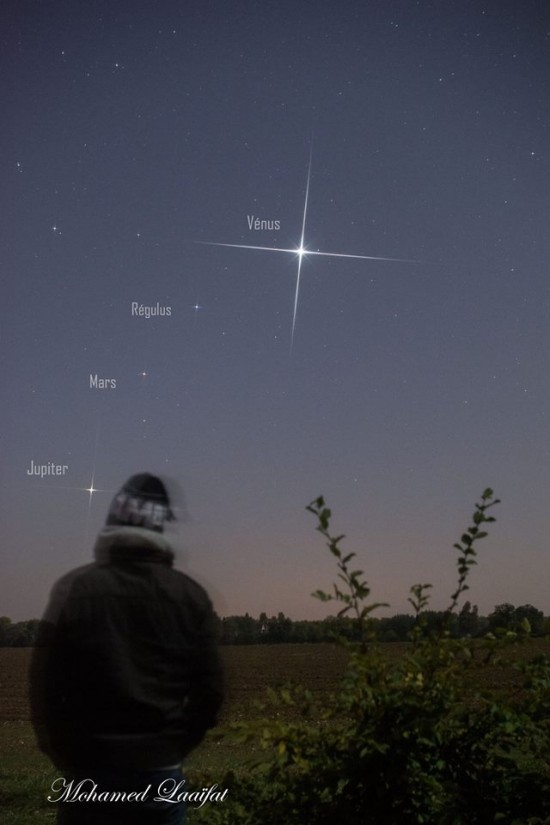
Jupiter pops out first thing at dusk. It’s the brightest starlike object in May and lights up the nighttime until the wee hours of the morning. Mars and Saturn ascend in the east at early-to-mid evening. Once Mars and Saturn are up, they’re out for rest of the night, near each other, getting brighter, heading toward their brightest and best in late May and early June, respectively. Mars and Saturn join up with the bright star Antares to form a bright celestial triangle: beautiful and easy to spot. Mercury transits the sun on May 9, 2016, for the first time since November 8, 2006. The brightest planet – Venus – is lost in the glare of sunrise. Follow the links below to learn more about the May planets.
Check out our latest EarthSky visible planet tee available only for a limited time!
Jupiter brightest “star” in early May
Mars, early evening until dawn, reaches opposition this month
Saturn, early evening until dawn, shines near Mars
Mercury transits sun on May 9
Venus, brightest planet, lost in the sunrise
Like what EarthSky offers? Sign up for our free daily newsletter today!
Astronomy events, star parties, festivals, workshops

Watch for the waxing moon to move eastward in front of the constellation Leo the Lion for several days around May 13, 14 and 15. The green line depicts the ecliptic – the sun and moon’s yearly path in front of the constellations of the Zodiac. Read more.
Jupiter brightest “star” in early May. Jupiter lights up the sky almost immediately after sunset. From mid-northern latitudes, it shines in the southern sky at nightfall. From the Southern hemisphere, look high overhead at nightfall.
This giant planet climbs highest up for the night at roughly 8 to 9 p.m. local time (9 to 10 p.m. local Daylight Saving Time) and sets in the west before dawn.
Jupiter will remain a fine evening object for months to come.
Jupiter is almost impossible to miss. However, from southerly latitudes, it might be possible to confuse it with sparkling, blue-white Sirius, the brightest star in the night sky. At nightfall and early evening, Jupiter is either in the southern sky or high overhead, while Sirius shines to the west of Jupiter, in the western sky. From either the Northern or Southern Hemisphere, you can rely on the famous constellation Orion the Hunter to confirm that you’re looking at Sirius, and not Jupiter, because Orion’s Belt of three stars points right to this star.
But just wait. As the month of May passes, the planet Mars is brightening dramatically. By the month’s end, Mars will have attained Jupiter’s brightness, almost. It’ll be harder to mistake Mars for Jupiter, because Mars will be distinctly reddish.
The moon swings close to Jupiter on the sky’s dome for several days, centered on May 14.
If you have binoculars or a telescope, it’s fairly easy to see Jupiter’s four major moons, which look like pinpricks of light on or near the same plane. They are often called the Galilean moons to honor Galileo, who discovered these great Jovian moons in 1610. In their order from Jupiter, these moons are Io, Europa, Ganymede and Callisto.
These moons circle Jupiter around the Jovian equator. In cycles of six years, we view Jupiter’s equator edge-on. So, in 2015, we got to view a number of mutual events involving Jupiter’s moons through a high-powered telescope. Click here or here or here for more details.
Although Jupiter’s axial tilt is only 3o out of perpendicular relative to the ecliptic (Earth’s orbital plane), Jupiter’s axis will tilt enough toward the sun and Earth so that the farthest of these four moons, Callisto, will NOT pass in front of Jupiter or behind Jupiter for a period of about three years, starting in late 2016. During this approximate 3-year period, Callisto will remain “perpetually” visible, alternately swinging “above” and “below” Jupiter.
Click here for a Jupiter moons almanac, courtesy of Sky & Telescope.

Look for the Blue Moon to pair up with Mars on the sky’s dome on May 21. The green line depicts the ecliptic – Earth’s orbital plane projected onto the dome of sky.
Mars, early evening until dawn, reaches opposition this month Mars is not as bright as Jupiter when the month begins, but this is Mars’ month, the best month in two years to watch the red planet!
Mars will brighten throughout May until its opposition on May 22.
By the time Mars reaches its crest of brightness in late May 2016, it will have quadrupled in brilliance since the beginning of April. Mars has greater swings in brilliance than any other solar system planet, except for Mercury, and is a fascinating and beautiful sight in May, 2016.
At is brightest, Mars shines some 80 times more brilliantly than at its faintest.
Why is Mars getting so bright? For most of the past two years, Earth has been fleeing ahead of Mars in orbit. Mars orbits just one step outward from us, and we move slightly faster in orbit, and – about every two years – we catch up to Mars again and pass between it and the sun. That’ll happen next in late May, 2016. Astronomers will say that Mars is in opposition to the sun around that time.
Then, believe it or not, Mars will nearly match Jupiter in brightness!
By late May, as we pass between it and the sun, Mars will be rising in the east as the sun is setting in the west. It’ll be opposite the sun, in opposition.
In early May, Mars rises at about 9 p.m. local time (10 p.m. Daylight Time) at mid-northern latitudes. By the month’s end, Mars – opposite the sun – will ascend above the horizon as the sun is setting in the west.
Looking for a sky almanac? EarthSky recommends…
And here’s the really good news. Mars is near another planet on the sky’s dome, Saturn. Look for Mars and Saturn near Antares, the brightest star in the constellation Scorpius the Scorpion. They make a noticeable triangle on the sky’s dome.
Let the moon help guide your eye to Mars (and Saturn) in the morning sky for several nights, beginning around May 20, and also on May 21 and May 22.

What’s really cool is that you can use the brilliant planet Mars as you guide “star” to the planet Saturn and the star Antares for months to come.
Saturn, early evening until dawn, shines near Mars. And both Mars and Saturn are near a fainter object – still one of the sky’s brightest stars – Antares in the constellation Scorpius.
From mid-northern latitudes, the ringed planet starts the month rising in the east around 9 to 10 p.m. local time (10 to 11 p.m. local Daylight Saving Time). As for temperate latitudes in the Southern Hemisphere, Saturn rises in the east at roughly 7 to 8 p.m. local time in early May. By the month’s end – no matter where you are on Earth – Saturn will be coming up around sunset, just a few days shy of its opposition, when Earth will pass between Saturn and the sun. That will happen on June 3.
Although Saturn shines on par with the sky’s brightest stars, its brilliance can’t match that of Mars. Look for Saturn near Mars. These two worlds form a bright celestial triangle with the star Antares in the May night sky. Mars is brighter than Saturn, which in turn is brighter than Antares.
Mars will eventually catch up with Saturn on August 24, 2016, to present a conjunction of these two worlds in the August evening sky.
Watch for the moon to swing by Saturn for several days, centered on or near May 22. Scroll up to the second sky chart above.
Saturn, the farthest world that you can easily view with the eye alone, appears golden in color. It shines with a steady light. Binoculars don’t reveal Saturn’s gorgeous rings, by the way. For that, you need a small telescope. But binoculars will enhance Saturn’s golden color.
Saturn’s rings are inclined at a little more than 26o from edge-on in May, 2016, exhibiting their northern face. Next year, in October, 2017, the rings will open most widely, displaying a maximum inclination of 27o.
As with so much in space (and on Earth), the appearance of Saturn’s rings from Earth is cyclical. In the year 2025, the rings will appear edge-on as seen from Earth. After that, we’ll begin to see the south side of Saturn’s rings, to increase to a maximum inclination of 27o by May, 2032.
Click here for recommended almanacs. They can help you know when the planets rise, transit and set in your sky
Transit of Mercury on May 9, 2016 from LarryKoehn on Vimeo. Visit Larry’s great website shadowandsubstance.com
Mercury transits the sun on May 9, 2016. Mercury transitions from the evening to morning sky on May 9, 2016. Usually, you can’t see Mercury at this juncture because it swings to the north or south of the solar disk, so is lost in the sun’s glare.
This time around, however, the planet Mercury in its orbit will swing directly in between the Earth and sun on May 9, 2016. Mercury will appear as a small black dot in front of the sun. Warning: A telescope and a proper solar filter is absolutely essential to safely watch this transit, so you might want to seek out an astronomical organization hosting a public presentation of this event.
For the Southern Hemisphere, Mercury might become bright enough to view in the morning sky by late May. However, it’s really the first couple of weeks in June that will feature a good time for catching Mercury before sunrise in the Southern Hemisphere and the northern tropics. It’ll be more of a challenge to spot Mercury as a morning “star” from mid-northern latitudes. Mercury will reach its greatest western (morning) elongation on June 5, 2016.
Venus, brightest planet, lost in the sunrise. From all over the world, Venus sinks closer to the glare of sunrise all month long. From the Southern Hemisphere, you might be able to glimpse Venus before sunrise in the early part of May. From northerly latitudes, Venus will be extremely hard to catch this month. Venus will pass directly behind the sun on June 6, 2016, as it transitions from the morning to the evening sky.
Exactly four years previous to Venus passing directly behind the sun on June 6, 2016, Venus swung directly in front of the sun on June 6, 2012, to present the last transit of Venus until December 11, 2117. See the photo above.
What do we mean by bright planet? By bright planet, we mean any solar system planet that is easily visible without an optical aid and that has been watched by our ancestors since time immemorial. In their outward order from the sun, the five bright planets are Mercury, Venus, Mars, Jupiter and Saturn. These planets actually do appear bright in our sky. They are typically as bright as – or brighter than – the brightest stars. Plus, these relatively nearby worlds tend to shine with a steadier light than the distant, twinkling stars. You can spot them, and come to know them as faithful friends, if you try.
Bottom line: In May, 2016, Jupiter is the brightest starlike object up when the sun goes down. Earth swings between Mars and the sun on May 22, giving us our best view of the planet in about two years! Saturn and the bright star Antares make a triangle with Mars on the sky’s dome. Mercury, the innermost planet, tranists the sun on May 9. Venus is behind the sun.
Easily locate stars and constellations with EarthSky’s planisphere.
Don’t miss anything. Subscribe to EarthSky News by email

From late January, and through mid-February, 5 bright planets were visible at once in the predawn sky. This image is from February 8, 2016. It’s by Eliot Herman in Tucson, Arizona. View on Flickr.

Awesome month for planets before dawn: October, 2015! Photo taken October 2, 2015 by Mohamed Laaifat Photographies in Normandy, France.

Eastern sky before dawn now. Photo taken September 18, 2015 and submitted to EarthSky by Greg Hogan in Kathleen, Georgia. Thanks, Greg!

View larger. Evening dusk on August 5: Venus at left. Mercury is climbing higher, toward Regulus (at top) and Jupiter (beneath Regulus).

By the evening of July 12, Venus and Jupiter were farther apart and lower in the western sky after sunset. Photo by Robert Kelly. Thanks, Robert!

Photo taken June 13, 2015 by John Nelson at Puget Sound, Washington. Thanks, John!

Lunar eclipse on the night of October 8, 2014. The object to the left is the planet Uranus! This beautiful photo is by Janey Wing Kenyon of Story, Wyoming.

Debra Fryar in Calobreves, Texas captured this photo of the moon and Jupiter on May 31, 2014. Jupiter was close to the twilight then.

With only a modest backyard telescope, you can easily see Jupiter’s four largest moons. Here they are through a 10″ (25 cm) Meade LX200 telescope. Image credit: Jan Sandberg

Jupiter was rivaling the streetlights, when Mohamed Laaifat Photographies captured this photo in Normandy, France. Visit his page on Facebook.

Venus by Danny Crocker-Jensen

These are called star trails. It’s a long-exposure photo, which shows you how Earth is turning under the stars. The brightest object here is Jupiter, which is the second-brightest planet, after Venus. This awesome photo by EarthSky Facebook friend Mohamed Laaifat in Normandy, France. Thank you, Mohamed.

Skywatcher, by Predrag Agatonovic.
Easily locate stars and constellations with EarthSky’s planisphere.
Don’t miss anything. Subscribe to EarthSky News by email
from EarthSky http://ift.tt/IJfHCr

Jupiter pops out first thing at dusk. It’s the brightest starlike object in May and lights up the nighttime until the wee hours of the morning. Mars and Saturn ascend in the east at early-to-mid evening. Once Mars and Saturn are up, they’re out for rest of the night, near each other, getting brighter, heading toward their brightest and best in late May and early June, respectively. Mars and Saturn join up with the bright star Antares to form a bright celestial triangle: beautiful and easy to spot. Mercury transits the sun on May 9, 2016, for the first time since November 8, 2006. The brightest planet – Venus – is lost in the glare of sunrise. Follow the links below to learn more about the May planets.
Check out our latest EarthSky visible planet tee available only for a limited time!
Jupiter brightest “star” in early May
Mars, early evening until dawn, reaches opposition this month
Saturn, early evening until dawn, shines near Mars
Mercury transits sun on May 9
Venus, brightest planet, lost in the sunrise
Like what EarthSky offers? Sign up for our free daily newsletter today!
Astronomy events, star parties, festivals, workshops

Watch for the waxing moon to move eastward in front of the constellation Leo the Lion for several days around May 13, 14 and 15. The green line depicts the ecliptic – the sun and moon’s yearly path in front of the constellations of the Zodiac. Read more.
Jupiter brightest “star” in early May. Jupiter lights up the sky almost immediately after sunset. From mid-northern latitudes, it shines in the southern sky at nightfall. From the Southern hemisphere, look high overhead at nightfall.
This giant planet climbs highest up for the night at roughly 8 to 9 p.m. local time (9 to 10 p.m. local Daylight Saving Time) and sets in the west before dawn.
Jupiter will remain a fine evening object for months to come.
Jupiter is almost impossible to miss. However, from southerly latitudes, it might be possible to confuse it with sparkling, blue-white Sirius, the brightest star in the night sky. At nightfall and early evening, Jupiter is either in the southern sky or high overhead, while Sirius shines to the west of Jupiter, in the western sky. From either the Northern or Southern Hemisphere, you can rely on the famous constellation Orion the Hunter to confirm that you’re looking at Sirius, and not Jupiter, because Orion’s Belt of three stars points right to this star.
But just wait. As the month of May passes, the planet Mars is brightening dramatically. By the month’s end, Mars will have attained Jupiter’s brightness, almost. It’ll be harder to mistake Mars for Jupiter, because Mars will be distinctly reddish.
The moon swings close to Jupiter on the sky’s dome for several days, centered on May 14.
If you have binoculars or a telescope, it’s fairly easy to see Jupiter’s four major moons, which look like pinpricks of light on or near the same plane. They are often called the Galilean moons to honor Galileo, who discovered these great Jovian moons in 1610. In their order from Jupiter, these moons are Io, Europa, Ganymede and Callisto.
These moons circle Jupiter around the Jovian equator. In cycles of six years, we view Jupiter’s equator edge-on. So, in 2015, we got to view a number of mutual events involving Jupiter’s moons through a high-powered telescope. Click here or here or here for more details.
Although Jupiter’s axial tilt is only 3o out of perpendicular relative to the ecliptic (Earth’s orbital plane), Jupiter’s axis will tilt enough toward the sun and Earth so that the farthest of these four moons, Callisto, will NOT pass in front of Jupiter or behind Jupiter for a period of about three years, starting in late 2016. During this approximate 3-year period, Callisto will remain “perpetually” visible, alternately swinging “above” and “below” Jupiter.
Click here for a Jupiter moons almanac, courtesy of Sky & Telescope.

Look for the Blue Moon to pair up with Mars on the sky’s dome on May 21. The green line depicts the ecliptic – Earth’s orbital plane projected onto the dome of sky.
Mars, early evening until dawn, reaches opposition this month Mars is not as bright as Jupiter when the month begins, but this is Mars’ month, the best month in two years to watch the red planet!
Mars will brighten throughout May until its opposition on May 22.
By the time Mars reaches its crest of brightness in late May 2016, it will have quadrupled in brilliance since the beginning of April. Mars has greater swings in brilliance than any other solar system planet, except for Mercury, and is a fascinating and beautiful sight in May, 2016.
At is brightest, Mars shines some 80 times more brilliantly than at its faintest.
Why is Mars getting so bright? For most of the past two years, Earth has been fleeing ahead of Mars in orbit. Mars orbits just one step outward from us, and we move slightly faster in orbit, and – about every two years – we catch up to Mars again and pass between it and the sun. That’ll happen next in late May, 2016. Astronomers will say that Mars is in opposition to the sun around that time.
Then, believe it or not, Mars will nearly match Jupiter in brightness!
By late May, as we pass between it and the sun, Mars will be rising in the east as the sun is setting in the west. It’ll be opposite the sun, in opposition.
In early May, Mars rises at about 9 p.m. local time (10 p.m. Daylight Time) at mid-northern latitudes. By the month’s end, Mars – opposite the sun – will ascend above the horizon as the sun is setting in the west.
Looking for a sky almanac? EarthSky recommends…
And here’s the really good news. Mars is near another planet on the sky’s dome, Saturn. Look for Mars and Saturn near Antares, the brightest star in the constellation Scorpius the Scorpion. They make a noticeable triangle on the sky’s dome.
Let the moon help guide your eye to Mars (and Saturn) in the morning sky for several nights, beginning around May 20, and also on May 21 and May 22.

What’s really cool is that you can use the brilliant planet Mars as you guide “star” to the planet Saturn and the star Antares for months to come.
Saturn, early evening until dawn, shines near Mars. And both Mars and Saturn are near a fainter object – still one of the sky’s brightest stars – Antares in the constellation Scorpius.
From mid-northern latitudes, the ringed planet starts the month rising in the east around 9 to 10 p.m. local time (10 to 11 p.m. local Daylight Saving Time). As for temperate latitudes in the Southern Hemisphere, Saturn rises in the east at roughly 7 to 8 p.m. local time in early May. By the month’s end – no matter where you are on Earth – Saturn will be coming up around sunset, just a few days shy of its opposition, when Earth will pass between Saturn and the sun. That will happen on June 3.
Although Saturn shines on par with the sky’s brightest stars, its brilliance can’t match that of Mars. Look for Saturn near Mars. These two worlds form a bright celestial triangle with the star Antares in the May night sky. Mars is brighter than Saturn, which in turn is brighter than Antares.
Mars will eventually catch up with Saturn on August 24, 2016, to present a conjunction of these two worlds in the August evening sky.
Watch for the moon to swing by Saturn for several days, centered on or near May 22. Scroll up to the second sky chart above.
Saturn, the farthest world that you can easily view with the eye alone, appears golden in color. It shines with a steady light. Binoculars don’t reveal Saturn’s gorgeous rings, by the way. For that, you need a small telescope. But binoculars will enhance Saturn’s golden color.
Saturn’s rings are inclined at a little more than 26o from edge-on in May, 2016, exhibiting their northern face. Next year, in October, 2017, the rings will open most widely, displaying a maximum inclination of 27o.
As with so much in space (and on Earth), the appearance of Saturn’s rings from Earth is cyclical. In the year 2025, the rings will appear edge-on as seen from Earth. After that, we’ll begin to see the south side of Saturn’s rings, to increase to a maximum inclination of 27o by May, 2032.
Click here for recommended almanacs. They can help you know when the planets rise, transit and set in your sky
Transit of Mercury on May 9, 2016 from LarryKoehn on Vimeo. Visit Larry’s great website shadowandsubstance.com
Mercury transits the sun on May 9, 2016. Mercury transitions from the evening to morning sky on May 9, 2016. Usually, you can’t see Mercury at this juncture because it swings to the north or south of the solar disk, so is lost in the sun’s glare.
This time around, however, the planet Mercury in its orbit will swing directly in between the Earth and sun on May 9, 2016. Mercury will appear as a small black dot in front of the sun. Warning: A telescope and a proper solar filter is absolutely essential to safely watch this transit, so you might want to seek out an astronomical organization hosting a public presentation of this event.
For the Southern Hemisphere, Mercury might become bright enough to view in the morning sky by late May. However, it’s really the first couple of weeks in June that will feature a good time for catching Mercury before sunrise in the Southern Hemisphere and the northern tropics. It’ll be more of a challenge to spot Mercury as a morning “star” from mid-northern latitudes. Mercury will reach its greatest western (morning) elongation on June 5, 2016.
Venus, brightest planet, lost in the sunrise. From all over the world, Venus sinks closer to the glare of sunrise all month long. From the Southern Hemisphere, you might be able to glimpse Venus before sunrise in the early part of May. From northerly latitudes, Venus will be extremely hard to catch this month. Venus will pass directly behind the sun on June 6, 2016, as it transitions from the morning to the evening sky.
Exactly four years previous to Venus passing directly behind the sun on June 6, 2016, Venus swung directly in front of the sun on June 6, 2012, to present the last transit of Venus until December 11, 2117. See the photo above.
What do we mean by bright planet? By bright planet, we mean any solar system planet that is easily visible without an optical aid and that has been watched by our ancestors since time immemorial. In their outward order from the sun, the five bright planets are Mercury, Venus, Mars, Jupiter and Saturn. These planets actually do appear bright in our sky. They are typically as bright as – or brighter than – the brightest stars. Plus, these relatively nearby worlds tend to shine with a steadier light than the distant, twinkling stars. You can spot them, and come to know them as faithful friends, if you try.
Bottom line: In May, 2016, Jupiter is the brightest starlike object up when the sun goes down. Earth swings between Mars and the sun on May 22, giving us our best view of the planet in about two years! Saturn and the bright star Antares make a triangle with Mars on the sky’s dome. Mercury, the innermost planet, tranists the sun on May 9. Venus is behind the sun.
Easily locate stars and constellations with EarthSky’s planisphere.
Don’t miss anything. Subscribe to EarthSky News by email

From late January, and through mid-February, 5 bright planets were visible at once in the predawn sky. This image is from February 8, 2016. It’s by Eliot Herman in Tucson, Arizona. View on Flickr.

Awesome month for planets before dawn: October, 2015! Photo taken October 2, 2015 by Mohamed Laaifat Photographies in Normandy, France.

Eastern sky before dawn now. Photo taken September 18, 2015 and submitted to EarthSky by Greg Hogan in Kathleen, Georgia. Thanks, Greg!

View larger. Evening dusk on August 5: Venus at left. Mercury is climbing higher, toward Regulus (at top) and Jupiter (beneath Regulus).

By the evening of July 12, Venus and Jupiter were farther apart and lower in the western sky after sunset. Photo by Robert Kelly. Thanks, Robert!

Photo taken June 13, 2015 by John Nelson at Puget Sound, Washington. Thanks, John!

Lunar eclipse on the night of October 8, 2014. The object to the left is the planet Uranus! This beautiful photo is by Janey Wing Kenyon of Story, Wyoming.

Debra Fryar in Calobreves, Texas captured this photo of the moon and Jupiter on May 31, 2014. Jupiter was close to the twilight then.

With only a modest backyard telescope, you can easily see Jupiter’s four largest moons. Here they are through a 10″ (25 cm) Meade LX200 telescope. Image credit: Jan Sandberg

Jupiter was rivaling the streetlights, when Mohamed Laaifat Photographies captured this photo in Normandy, France. Visit his page on Facebook.

Venus by Danny Crocker-Jensen

These are called star trails. It’s a long-exposure photo, which shows you how Earth is turning under the stars. The brightest object here is Jupiter, which is the second-brightest planet, after Venus. This awesome photo by EarthSky Facebook friend Mohamed Laaifat in Normandy, France. Thank you, Mohamed.

Skywatcher, by Predrag Agatonovic.
Easily locate stars and constellations with EarthSky’s planisphere.
Don’t miss anything. Subscribe to EarthSky News by email
from EarthSky http://ift.tt/IJfHCr
